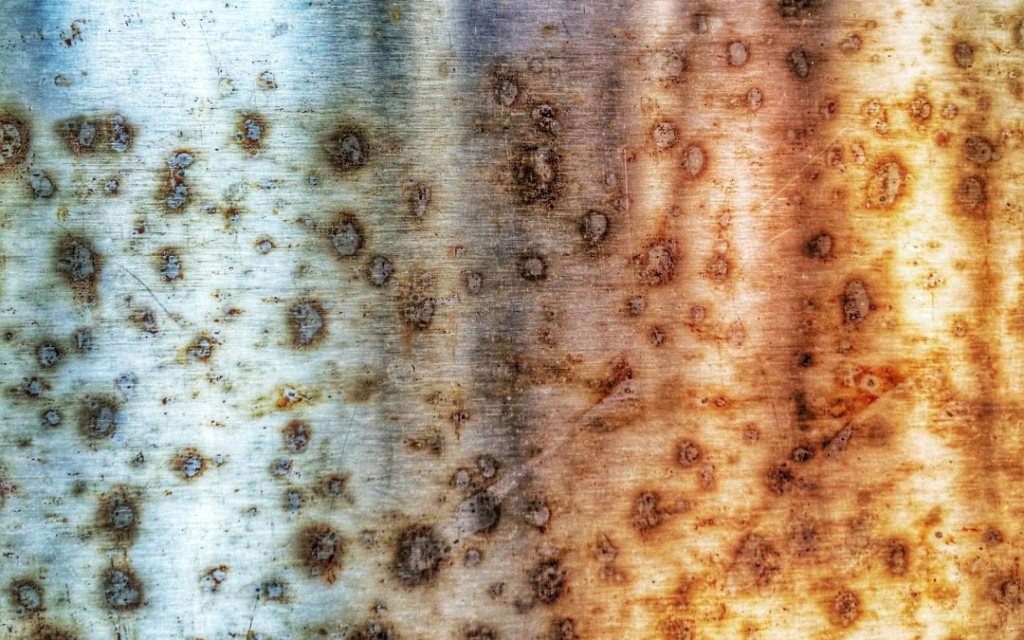
In this article, we will explore the question “Does aluminium oxidize?” Here are ten interesting things to know about aluminum oxidation:
- Does aluminium oxidize?
- What is the difference between aluminum oxidation and rust?
- How does aluminum oxidation affect the appearance of aluminum?
- What are some factors that can accelerate aluminum oxidation?
- How does temperature affect aluminum oxidation?
- What are some common applications of aluminum oxidation at high temperatures?
- What are some benefits of aluminum oxidation at high temperatures?
- Helpful Resources
Does aluminium oxidize?
1. Aluminum Oxidation: Aluminum has a strong affinity for oxygen, and when exposed to air, it forms a hard, whitish-colored surface skin called aluminum oxide.
2. Corrosion Resistance: Paradoxically, aluminum oxidation is a central part of its corrosion resistance. Aluminum oxide forms a protective layer on the surface, preventing the underlying aluminum from reacting with oxygen and other chemicals in the environment.
3. Natural Process: Aluminum oxidation is a natural process that occurs when aluminum is exposed to air. The resulting oxide layer sticks well to the surface and does not flake off easily, similar to the oxide layers on stainless steel.
4. Aesthetic Impact: Aluminum oxidation can affect the appearance of aluminum surfaces, forming a visible oxide layer. However, the oxide layer does not flake off, so the underlying aluminum’s appearance remains intact.
5. Environmental Factors: The rate of aluminum oxidation can be influenced by environmental factors such as temperature, humidity, and the presence of corrosive gases or salts.
6. Alloy Influence: The corrosion resistance of aluminum alloys can vary depending on the alloy composition. Some alloys, such as 5052 and 3003, have better corrosion-resistance properties than others.
7. Galvanic Corrosion: Aluminum is resistant to galvanic corrosion, which occurs when two different metals are in contact and one of them corrodes more rapidly than the other. However, the presence of alloying elements in aluminum can create galvanic couples that may accelerate corrosion.
8. Anodizing: The process of anodizing aluminum, which involves immersing aluminum in a chemical solution to form a protective oxide layer, can enhance the corrosion resistance of the material.
9. Paint and Powder Coatings: Aluminum can be coated with paint or powder coatings to improve its corrosion resistance. These coatings provide a barrier that prevents the underlying aluminum from reacting with oxygen and other chemicals in the environment.
10. Recyclability: Aluminum is 100% recyclable and retains its properties indefinitely. Recycling aluminum helps conserve energy and natural resources, and it is an environmentally friendly option compared to other materials that may not be as readily recyclable.
What is the difference between aluminum oxidation and rust?
The difference between aluminum oxidation and rust lies in the specific chemical processes and resulting compounds. Here are the key distinctions:
1. Chemical Composition: Rust is a specific type of corrosion that refers to the oxidation of iron or steel, resulting in the formation of iron oxide. On the other hand, aluminum undergoes a different type of corrosion, forming aluminum oxide.
2. Appearance: Rust typically appears as a flaky, reddish-brown substance, while aluminum oxide corrosion looks white, dull gray, or powdery white in color.
3. Protective Properties: Unlike rust, which expands and flakes off, exposing new metal to further corrosion, aluminum oxide forms a hard, protective layer that adheres well to the surface, preventing the underlying aluminum from reacting with oxygen and other chemicals in the environment.
4. Corrosion Resistance: Aluminum’s corrosion resistance is due to the formation of the aluminum oxide layer, which protects the metal from further corrosion. In contrast, rust does not provide the same level of protection and can lead to further corrosion of the underlying metal.
5. Galvanic Corrosion: Aluminum is resistant to galvanic corrosion, a specific type of corrosion that occurs when two different metals are in contact. In contrast, iron and steel are susceptible to galvanic corrosion.
In summary, while both processes involve the reaction of metal with oxygen, the resulting compounds, protective properties, and visual appearance of aluminum oxidation and rust are distinct.
Aluminum’s corrosion resistance is largely attributed to the formation of the protective aluminum oxide layer, which sets it apart from the rusting process observed in iron and steel.
How does aluminum oxidation affect the appearance of aluminum?
Aluminum oxidation affects the appearance of aluminum by forming a thin, hard, whitish-colored surface skin called aluminum oxide. This protective layer adheres well to the surface and prevents the underlying aluminum from reacting with oxygen and other chemicals in the environment.
Unlike rust, which flakes off, aluminum oxide does not flake and provides a protective barrier. However, heavy oxidation can occur over time, and it can be effectively removed from aluminum surfaces using various cleaning and polishing methods.
While aluminum oxidation is a natural process that occurs when aluminum is exposed to air, water, or soil, it can be minimized by applying protective coatings or mitigating the effects of galvanic corrosion.
Overall, aluminum oxidation is a central part of its corrosion resistance, and understanding its impact on the appearance of aluminum is essential for maintaining the metal’s visual and structural integrity.
What are some factors that can accelerate aluminum oxidation?
Several factors can accelerate aluminum oxidation, including:
1. High Concentrations of Dissolved Oxygen: The presence of high concentrations of dissolved oxygen can accelerate the corrosion process of aluminum, especially in acidic solutions.
2. pH Levels: The pH level of the environment can influence aluminum oxidation. For instance, the existence of carbonate and silica content in water can aggravate erosion-corrosion.
3. Presence of Chlorides: Chlorides, such as those found in seawater, can attack the aluminum oxide layer, accelerating the corrosion process.
4. Contact with Other Metals: When aluminum is in contact with certain metals, such as copper, brass, or noble metals, it can experience accelerated corrosion due to galvanic or dissimilar metal corrosion.
5. Environmental Factors: Environmental conditions, such as high humidity, exposure to corrosive gases, and the presence of heavy metals like copper, mercury, tin, nickel, and lead, can contribute to accelerated aluminum oxidation.
Understanding these factors is essential for mitigating the effects of aluminum oxidation and maintaining the durability of aluminum products.
How does temperature affect aluminum oxidation?
Temperature can have a significant impact on aluminum oxidation. Here are some key points from the search results:
1. Effect of Temperature: The rate and extent of aluminum oxidation can be influenced by temperature. Aluminum oxidizes rapidly at room temperature, and the oxide formed is stable up to relatively high temperatures. At temperatures between 650°C and 750°C, an induction period occurs before oxidation, while at 950°C, oxidation occurs more promptly. At temperatures above 1050°C, rapid passivation of the surface of the aluminum occurs.
2. Passivation: At high temperatures, aluminum can undergo passivation, which is the formation of a protective oxide layer that prevents further oxidation. However, the extent and duration of passivation can vary depending on the specific temperature range.
3. Corrosion Resistance: The corrosion resistance of aluminum can be affected by temperature, with high temperatures potentially leading to localized surface degradation and stress risers.
4. Environmental Factors: Temperature can interact with other environmental factors, such as humidity and the presence of corrosive gases or salts, to accelerate aluminum oxidation.
In summary, temperature can have a significant impact on aluminum oxidation, with high temperatures potentially leading to passivation and localized surface degradation.
Understanding the effects of temperature on aluminum oxidation is essential for maintaining the durability and corrosion resistance of aluminum products.
What are some common applications of aluminum oxidation at high temperatures?
Some common applications of aluminum oxidation at high temperatures include:
1. Aerospace: Aluminum’s lightweight, high strength, and excellent corrosion resistance make it an ideal choice for various aerospace applications. Aluminum oxidation at high temperatures is a complex phenomenon that can have significant implications for the performance and durability of aerospace components.
2. Automotive: Aluminum is widely used in the automotive industry due to its numerous benefits, such as being a good conductor of heat and electricity, having a high strength-to-weight ratio, and having excellent corrosion resistance. Understanding the effects of aluminum oxidation at high temperatures is crucial for maintaining the performance and longevity of automotive components.
3. Heat Management: Aluminum’s heat transfer properties make it an excellent choice for various heat management applications, such as radiators, heat exchangers, and heat sinks. Aluminum oxidation at high temperatures can affect the material’s thermal conductivity, which is essential for efficient heat management.
4. Electrical Conductivity: Aluminum’s excellent electrical conductivity makes it a popular choice for electrical applications, such as electrical wiring and connectors. High temperatures can cause aluminum oxidation, which can impact the electrical performance of these components.
5. High-Temperature Structural Components: Aluminum’s corrosion resistance and strength make it suitable for high-temperature structural components, such as aircraft frames and automotive components. The oxidation process at high temperatures can affect the material’s properties and performance, making it essential to select appropriate materials and protective coatings.
In summary, aluminum oxidation at high temperatures has various applications, including aerospace, automotive, heat management, electrical conductivity, and high-temperature structural components.
Understanding the factors influencing oxidation and developing suitable mitigation strategies are crucial for maintaining the performance and durability of these components.
What are some benefits of aluminum oxidation at high temperatures?
There are several benefits of aluminum oxidation at high temperatures, including:
1. Corrosion Resistance: Aluminum oxidation at high temperatures can contribute to the corrosion resistance of aluminum products, as the oxide layer forms a protective barrier that prevents the underlying aluminum from reacting with oxygen and other chemicals in the environment.
2. Passivation: At high temperatures, aluminum can undergo passivation, which is the formation of a protective oxide layer that prevents further oxidation. This passivation can enhance the durability and longevity of aluminum products.
3. Heat Management: Aluminum’s heat transfer properties make it an excellent choice for various heat management applications, such as radiators, heat exchangers, and heat sinks. Aluminum oxidation at high temperatures can affect the material’s thermal conductivity, which is essential for efficient heat management.
4. Electrical Conductivity: Aluminum’s excellent electrical conductivity makes it a popular choice for electrical applications, such as electrical wiring and connectors. High temperatures can cause aluminum oxidation, which can impact the electrical performance of these components.
5. High-Temperature Structural Components: Aluminum’s corrosion resistance and strength make it suitable for high-temperature structural components, such as aircraft frames and automotive components. The oxidation process at high temperatures can affect the material’s properties and performance, making it essential to select appropriate materials and protective coatings.
In summary, aluminum oxidation at high temperatures can enhance the corrosion resistance, passivation, heat management, electrical conductivity, and durability of aluminum products.
Understanding the factors influencing oxidation and developing suitable mitigation strategies are crucial for maintaining the performance and longevity of these components.
Helpful Resources
- https://www.wileymetal.com/aluminum-corrosion-why-it-happens-and-what-to-do-when-it-does/
- https://www.kloecknermetals.com/blog/aluminum-oxidation-is-aluminum-corrosion-resistant/
- https://fractory.com/aluminium-corrosion/
- https://www.allmetalsfab.com/does-aluminum-rust/
- https://www.theruststore.com/Does-Aluminum-Rust-W26.aspx
- https://www.corrosionpedia.com/understanding-aluminum-corrosion/2/6954
- https://www.alfed.org.uk/files/Fact%20sheets/2-aluminium-and-corrosion.pdf
- https://www.researchgate.net/figure/Graph-showing-the-effect-of-temperature-on-the-oxidation-of-aluminium-in-dry-air_fig4_237719881
- https://www.mdpi.com/2076-3417/13/1/229
- https://www.ncbi.nlm.nih.gov/pmc/articles/PMC7435424/
- https://digital.library.unt.edu/ark:/67531/metadc833953/m2/1/high_res_d/1096501.pdf
- https://www.whattemperature.net/the-different-uses-of-aluminum-at-high-temperatures/?amp=1
- https://www.osti.gov/biblio/1096501
- https://thecorrecter.com/how-to-insulate-aluminium-window-frames/
- https://thecorrecter.com/how-to-fix-aluminium-window-hinges/
- https://thecorrecter.com/how-to-stop-condensation-on-aluminium-window-frames/
- https://thecorrecter.com/can-aluminium-be-brazed/
- https://thecorrecter.com/is-aluminium-dust-harmful/
- https://thecorrecter.com/how-to-melt-aluminium-without-a-foundry/
- https://thecorrecter.com/is-aluminium-foil-a-good-insulator-of-heat/
- https://thecorrecter.com/is-aluminium-oxide-ionic-or-covalent/
- https://thecorrecter.com/can-aluminium-be-magnetised/
- https://thecorrecter.com/is-aluminium-monatomic-or-diatomic/
- https://thecorrecter.com/is-aluminium-toxicity-reversible/
- https://thecorrecter.com/what-to-do-if-you-accidentally-eat-aluminum-foil/
- https://thecorrecter.com/can-you-put-aluminium-foil-in-an-air-fryer/
- https://thecorrecter.com/what-size-aluminium-wire-for-125-amp-service/
- https://thecorrecter.com/how-to-remove-scratches-from-aluminium-4/
- https://thecorrecter.com/how-is-aluminium-mined-2/
- https://thecorrecter.com/is-aluminium-malleable-and-ductile/
- https://thecorrecter.com/does-aluminium-cause-dementia-2/
- https://thecorrecter.com/how-to-remove-anodising-from-aluminium-2/
- https://thecorrecter.com/how-to-restore-aluminium-boat/
- https://thecorrecter.com/how-does-aluminium-cans-affect-the-environment/
- https://thecorrecter.com/can-aluminium-be-soldered/
